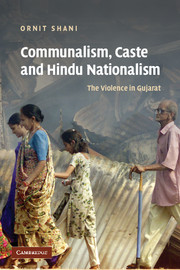Book contents
- Frontmatter
- Contents
- Acknowledgements
- Glossary
- List of abbreviations
- Map of Ahmedabad
- Introduction
- Part I The background
- 1 Setting the scene
- 2 The politics and discourse of reservations and caste
- Part II The 1985 Ahmedabad riots: the historical conjunction between caste conflicts and communalism
- Part III The making of ethnoHinduism
- Bibliography
- Index
1 - Setting the scene
Published online by Cambridge University Press: 04 December 2009
- Frontmatter
- Contents
- Acknowledgements
- Glossary
- List of abbreviations
- Map of Ahmedabad
- Introduction
- Part I The background
- 1 Setting the scene
- 2 The politics and discourse of reservations and caste
- Part II The 1985 Ahmedabad riots: the historical conjunction between caste conflicts and communalism
- Part III The making of ethnoHinduism
- Bibliography
- Index
Summary
Until the beginning of the twentieth century most of Ahmedabad's population resided within the Fort Walls on the eastern bank of the Sabarmati river. The opening of the first Ahmedabad textile mill in 1861 and of the railway line between Ahmedabad and Bombay three years later was a harbinger of the city's rapid expansion. The developing textile industry generated waves of migration into the city and extensive growth of its population and territory. In 1872 Ahmedabad's population was 119,672; it had increased to 185,889 by the turn of the century; by 1961, immediately after the formation of Gujarat, it had risen to 1,149,918, and by 1985 had more than doubled to 2,387,938. Over a century the city's area grew seventeen-fold: from 5.72 sq. km in 1872 to 98.15 sq. km in 1981.
The growth of the city and the demographic developments wrought profound social and economic changes among its social groups. Processes of urbanisation also restructured the city's layout. These transformations affected the dynamics of interrelations between caste and class and resulted in growing tensions among Hindus. The way the city developed was a factor in the shaping of these patterns of intra-Hindu group relations. The emerging social conflicts were inscribed on Ahmedabad's urban landscape. In particular, the social and economic transformation, the changing spatial organisation of the city and the developing pattern of settlements reflected processes of growing class segregation and fissures among castes. These changes unsettled the location of various groups within the ‘Hindu order’.
- Type
- Chapter
- Information
- Communalism, Caste and Hindu NationalismThe Violence in Gujarat, pp. 25 - 51Publisher: Cambridge University PressPrint publication year: 2007



